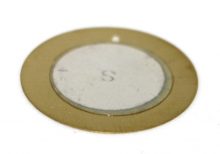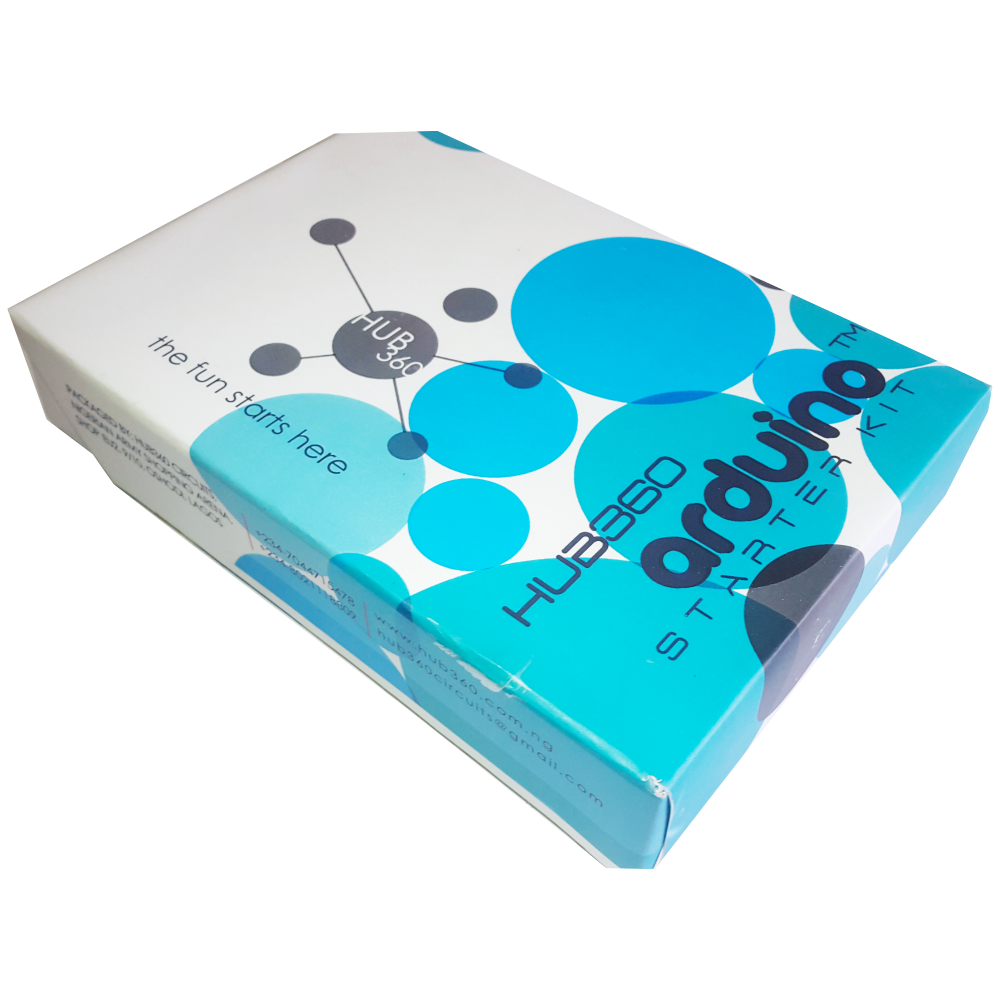|
Description |
The Piezoelectric Transducer 27mm is a compact and efficient device used for converting electrical signals into mechanical vibrations or sound waves. It is commonly used in buzzers, alarms, and ultrasonic applications due to its ability to generate precise and high-frequency sounds. The transducer is highly reliable, lightweight, and suitable for various electronic projects and devices.
Key Features:
- High Sensitivity: Efficiently converts electrical energy into mechanical vibrations.
- Compact Size: 27mm diameter, suitable for space-constrained applications.
- Wide Frequency Range: Capable of generating a broad range of frequencies.
- Low Power Consumption: Operates efficiently with minimal power.
- Durable Construction: Designed for long-lasting performance.
- Easy Integration: Simple to integrate into various circuits and devices.
Technical Specifications:
- Diameter: 27mm
- Resonant Frequency: Typically around 4 kHz (varies by model)
- Capacitance: Typically 2000 pF at 1 kHz (varies by model)
- Operating Voltage: 3V to 30V (varies by model)
- Sound Pressure Level: Typically 85 dB at 10 cm and 5V (varies by model)
- Operating Temperature Range: -20°C to +60°C
- Material: Metal and ceramic
Applications:
- Buzzers and Alarms: Used in buzzers, alarms, and warning systems.
- Ultrasonic Cleaners: Integrated into ultrasonic cleaning devices.
- Medical Devices: Utilized in medical equipment for ultrasonic applications.
- Sonar Systems: Employed in sonar systems for underwater detection.
- Musical Instruments: Used in electronic musical instruments for sound generation.
- DIY Projects: Suitable for hobbyist and educational electronic projects.
Usage:
- Wiring: Connect the transducer to the appropriate points in your circuit, typically using driver circuits to control the input signal.
- Power Supply: Ensure the transducer is supplied with the correct voltage to prevent damage.
- Mounting: Secure the transducer in place within your device, ensuring it has sufficient space to vibrate freely.
- Testing: Test the transducer by applying the input signal and verifying the sound output or vibration.
Caution:
- Handling: Handle with care to avoid damage to the ceramic element.
- Voltage: Ensure correct voltage levels to avoid overloading the transducer.
- Environmental Conditions: Use within the specified temperature range to maintain performance.
Datasheet:
For detailed technical specifications, refer to the Piezoelectric Transducer 27mm Datasheet.
|
The Hub360 Arduino Starter Kit is a comprehensive package designed for beginners and enthusiasts looking to dive into the world of electronics and programming. This kit includes Arduino Uno, which is a microcontroller board based on the ATmega328P. The kit provides a variety of components and modules to help users learn and experiment with different electronic projects and concepts.
Key Features:
- Includes Arduino Uno board
- Comprehensive set of components and modules for various projects
- Ideal for beginners and hobbyists
- Detailed tutorial and project guide included
- USB interface for easy programming and power
- Compatible with Arduino IDE and various libraries
Technical Specifications:
- Microcontroller: ATmega328P
- Operating Voltage: 5V
- Input Voltage (recommended): 7-12V
- Digital I/O Pins: 14 (6 PWM outputs)
- Analog Input Pins: 6
- DC Current per I/O Pin: 20mA
- Flash Memory: 32KB (ATmega328P) of which 0.5KB used by bootloader
- SRAM: 2KB (ATmega328P)
- EEPROM: 1KB (ATmega328P)
- Clock Speed: 16 MHz
Kit Contents:
- ARDUINO BOARD 1
- ARDUINO USB CABLE 1
- ARDUINO BATTERY CONNECTOR 1
- 400 HOLE BREADBOARD 1
- LED (RED, YELLOW , GREEN, WHITE) 20
- RGB LED 1
- JUMPER WIRE(M-M, M-F, F-F) 120
- PHOTORESISTOR (LDR) 3
- MALE HEADERS 40
- ULTRASONIC SENSOR 1
- FLAME SENSOR 1
- TEMP./HUMIDITY SENSOR 1
- TILT SENSOR 1
- LASER SENSOR 1
- PIR MOTION SENSOR 1
- RESISTORS(220K, 1K, 10K,100K) 40
- 7 SEGMENT DISPLAY 1
- SG90 SERVO 1
- REMOTE CONTROL 1
- BUZZER 1
- 2N2222 2
- TSOP 1838 1
- RF TRANSMITTER 1
- RF RECEIVER 1
- TACT SWITCH 5
- 16*2 LCD DISPLAY
Applications:
- Learning basic electronics and programming
- Building interactive projects and prototypes
- Developing skills in microcontroller-based design
- Experimenting with sensors and actuators
- Creating DIY electronic devices
Usage:
- Setup:
- Connect the Arduino Uno board to your computer using the USB cable.
- Install the Arduino IDE and configure it to recognize the board.
- Programming:
- Write or upload sample code (sketches) to the Arduino board using the Arduino IDE.
- Utilize the provided components and modules to build and test different circuits.
- Experimentation:
- Follow the detailed tutorials and project guide to create various projects.
- Modify and expand on the sample projects to enhance learning and creativity.
Caution:
- Handle the components carefully to avoid damage.
- Ensure proper connections and polarity to prevent short circuits or component failure.
- Verify the code and circuit connections before powering the board.
Datasheet:
For detailed technical specifications of the Arduino Uno, refer to the Arduino Uno Datasheet.
|
The Inductive Metal Sensor SNO4 is a high-precision sensor designed for detecting the presence of metallic objects through electromagnetic induction. This sensor is ideal for applications in automation and industrial processes where non-contact metal detection is required. It is robust, reliable, and suitable for use in various environments, making it a popular choice for industrial and engineering applications.
Key Features:
- Detection Method: Electromagnetic induction
- Sensing Range: Typically 4 mm for metal objects
- Output Type: NPN or PNP (depending on model)
- Operating Voltage: 10-30V DC
- Response Time: Fast response for accurate detection
- Durability: Designed for industrial environments
- Housing Material: Usually metal or high-quality plastic
Technical Specifications:
- Dimensions:
- Sensor Diameter: 12 mm
- Length: 40 mm
- Weight: Approximately 20 g
- Operating Voltage: 10-30V DC
- Detection Range: Up to 4 mm (for iron)
- Output Type:
- NPN: Normally open or normally closed
- PNP: Normally open or normally closed
- Response Time: <1 ms
- Operating Temperature Range: -25°C to +75°C
- Cable Length: 1.5 meters (typically, varies by supplier)
- Connector Type: Cable or connector (depends on model)
Applications:
- Automation: Used in automated systems for detecting the presence or absence of metal objects.
- Manufacturing: Ideal for quality control and detection of metal parts on production lines.
- Robotics: Helps in obstacle detection and metal part positioning in robotic systems.
- Safety Systems: Integrated into safety systems to ensure proper operation and prevent collisions.
- Industrial Processes: Used in various industrial processes for metal detection and monitoring.
Datasheet:
For detailed technical information, refer to the Inductive Metal Sensor SNO4 Datasheet.
|
The 125KHZ RFID Card is a contactless proximity card used for various identification and access control applications. It operates at a frequency of 125kHz and contains a unique identification number (UID) for each card. This card is durable and convenient, making it ideal for use in security systems, time and attendance tracking, and membership management.
Key Features:
- Operates at 125kHz frequency
- Durable PVC material
- Compatible with standard 125kHz RFID readers
- Unique identification number (UID) for each card
- Waterproof and tamper-resistant
- Long read range (up to 10 cm depending on the reader)
- No battery required (passive RFID technology)
Technical Specifications:
- Operating Frequency: 125kHz
- Material: PVC plastic
- Dimensions: 85.6mm x 54mm x 0.8mm (standard credit card size)
- Weight: Approximately 6g
- Read Range: Up to 10 cm (depending on the reader and environment)
- Data Storage: 64-bit read-only unique identifier (UID)
- Operating Temperature Range: -25°C to +85°C
- Color: Typically white, but may vary by manufacturer
- Waterproof: Yes
Applications:
- Access control systems
- Time and attendance tracking
- Membership management
- Asset tracking
- Secure entry systems
- Contactless payment systems
Usage:
- Integration:
- Enroll the RFID card in the desired RFID system by registering its unique identifier (UID) with the system’s database.
- Operation:
- Present the card to an RFID reader within the read range (up to 10 cm).
- The reader will capture the UID and communicate it to the control system for processing.
- Security:
- Use the card for secure access to restricted areas or for tracking attendance.
- Pair the card with a compatible RFID reader and control system for seamless operation.
Caution:
- Avoid exposing the card to extreme temperatures or harsh chemicals.
- Do not bend or apply excessive force to the card to prevent damage.
- Keep the card away from strong magnetic fields to ensure proper operation.
Datasheet:
For detailed technical specifications, refer to the manufacturer’s datasheet for your specific 125kHz RFID card model.
|



